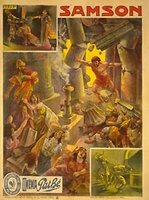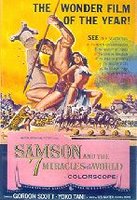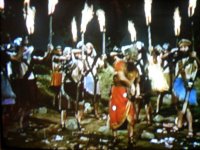
First off, let me start by saying that I realise this is a bit tenuous, but sometimes idle speculation can be a lot of fun and not entirely worthless so I though I'd post this anyway.
I'm currently running a course called
Through the Bible in Five and a Half Years, and this month we're looking at the book of
Judges. It's about eleven years since I did some detailed study on the book, but one of the things I remembered thinking all that time ago was how Judges was the
Pulp Fiction of the Bible.
It's no doubt partly down to the fact that I first watched
Pulp Fiction at around the same time, and partly down to the fact that there I was encountering various literary features of the book which I'd not really come across before. Anyway, as part of my preparation for Monday's session I thought I'd re-watch it, particular as I've not seen it since that initial viewing.
The comparison with Judges is certainly interesting. There's not been a film made about the book as a whole, at least not as far as I'm aware. Furthermore, despite a number of interesting, colourful, narratives only two characters have been represented in film at all. The first is
Gideon who has only featured in two obscure films -
Great Leaders of the Bible: Gideon (1965/6), and
Gideon: The Liberator (1958). The other is, of course
Samson. About a year ago
I listed at least 49 films about the legendary strongman, and the recent appearance of Corina van Eijk's
Samson and Delilah nudges that tally up to 50 (making his the second most filmed biblical story after Jesus).

The two things that first led me to connect Judges and
Pulp Fiction were the violence in each story and the non-linear chronology. At first citing "violence" appears somewhat superficial - after all much of the Old Testament is horrifically violent. Yet Judges particularly seems to revel in the violence, and at times use it for humour, and the same could be said of
Pulp Fiction. The most pertinent example from Judges is when Ehud's sword is swallowed up by Eglon's fat belly. The narrator seems to wallow in this detail and delight in spelling it out. It's worth pointing out that Ehud is effectively a hit man. The same could point could be made about Samson (although from the perspective of the Philistines his final act is perhaps a suicidal act of terrorism).
Pulp Fiction was Quentin Tarantino's second film, and the violence was much commented on at the time. Indeed Tarantino's first film
Reservoir Dogs was initially banned from video release due to it's violent imagery.
The second point is the non-linear narrative style that both writers adopt. At the time of the film's release this was one of the film's two major talking points (the other being the snappy dialogue). The film ends with the same scene it started with, albeit from a different perspective. Furthermore rather than the film consisting of one main story split into many different scenes, this is more of a collection of stories woven into a broader narrative. In between the opening and closing stories various other stories are told which, chronologically speaking, are from both before and after it. Whilst there is no one-reason why Tarantino adopted this approach, Roger Ebert noted how "if you told the story in chronological order that would get monotonous, this way the audience stays on its toes".
1 Certainly the tension that emerges in that final scene would have been greatly dissipated. Re-arranging the chronology of the individual parts of the story allows the film to draw different themes to the fore.

In the same way, Judges consists of a collection of individual stories sewn together to form a broader narrative. Indeed it's noticeable that whereas these various stories generally only concern a tribe or two at a time, the redactor uses them to comment on what was happening in the whole of Israel at that moment in time. Now whilst a minority of scholars would still claim that the historical data presented in Judges is accurate, the vast majority, including many conservative scholars, consider the chronology to have been highly stylised in order to give the overall story greater impact. Judges contains a prologue and epilogue that are often held to be later additions to the text, and these are generally set aside when looking at the core of the book's literary structure.
Both works have a kind of symmetry with their opening and closing stories both reflecting one another, but also being notably different. In
Pulp Fiction we see the same scene, but from a different perspective. In Judges the differences are more significant that the similarities, but we effectively see Ehud paired off with Samson. As noted above, both are lone hit men whose actions are so strategic that they turn the course of the conflict decisively in Israel's favour. Whilst the similarities in Judges are weaker, this chiastic pairing is continued as we move towards the core of the book. Deborah and Jephthah are both social outcasts who Israel calls in during a desperate period to lead them to great victory. Both victories require the one of the heroes to break a part of their respective social codes. Whilst Jael's disregard for hospitality seems, to us, trivial compared with Jephthah breaking the laws against child sacrifice, the two taboos would have been far closer in the minds of those at the time. The final pairing is Gideon and Abimelech who are almost opposite in terms of their character and their faithfulness to God - and it's this contrast between faithfulness and unfaithfulness, and the impact of each, that is the book's major concern.
By contrast,
Pulp Fiction uses it's non-linear chronology to shield the film's major theme from the viewer until the end. When the sequence of events is unjumbled it becomes apparent that both Jules and Vincent both witnessed the same "miracle", but responded to it in very different ways. Jules realises that he has to leave his life as a hit man behind him. Vincent carries on as before and is shot by Butch shortly afterwards. In fact "every one of the major sequences in Pulp Fiction ends with a character being saved".
2 Mia is saved from her drug overdose, Butch is saved from a life on the run. Pumpkin and Honeybunny are saved from the new style life of crime they were about to embark on, and Jules is saved from his life as a hitman.

This leads to a further similarity then: both works are deeply moral calling their protagonists to leave behind them horrifically sinful lives and be righteous. Samuel L Jackson, who plays Jules in the movie claims that "the story is totally about redemption. Everyone in the script who's life is spared is given another chance to do something with their lives".
3 In this way it actually differs from Judges.
Pulp Fiction's moral cycle works it's way up. It's greatest act of salvation occurs at the end of the movie. By contrast, Judges portrays a downward spiral where the morality of the characters descends with each new segment.
It's easy to be so disturbed by the degradation that is on display in
Pulp Fiction that this theme is missed, and not dissimilarly its surprisingly how many of those reading Judges fail feel to feel the heaviness with which the author regards his countrymen's apostasy. Actually both find characters pulling their way to bloody salvation - both spiritually and in terms of their physical security, and the end to the threats under which they had previously been held.
I'm sure I had a few more observations, but they all escape me for the time being. I'll post up any that come back to me.
1 - Roger Ebert on "Siskel and Ebert - At the Movies: Pulp Faction"
2 - Roger Ebert on "Siskel and Ebert - At the Movies: Pulp Faction"
3 - Roger Ebert on "Siskel and Ebert - At the Movies: Pulp Faction"Labels: Gideon, Judges, Other Films, Samson, Silent Bible Films


























.jpg)














